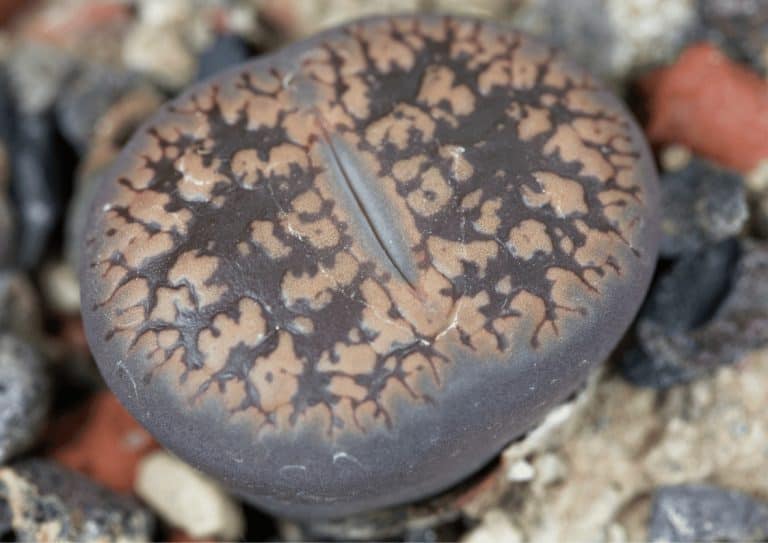When Do Lithops Split? [Season + Timeline]
- Lakeisha Ethans
- July 25, 2022
If you buy something using the retail links in our articles, sometimes we earn a small affiliate commission. This does not impact the products we recommend.
The Lithops, also known as the Living Stone plant, is a genus of ice plant succulents native to southern Africa. These unique plants resemble pebbles or rocks and primarily consist of one or more bulbous pairs of leaves. These pairs are closely pressed together and appear almost fused, but at some point, the pairs begin to separate. This is known as splitting.
The splitting of Lithops is quite exciting for any owner of this interesting plant, as it is a sign of future growth and development. If you’re sitting around impatiently waiting for the first sign of a split, you may wonder when exactly this big change will occur. You may even be concerned that your Lithops aren’t splitting quickly enough.
Lithops split during their cold month growing season, which is typically in autumn. The plants have a unique annual growth cycle and produce and push out new growth once a year. The split can take up to half a year to reach completion, though new growth from the split usually shows within a few weeks.
Of course, Lithops plants can be unpredictable, depending on their environment and the seasons of the region where they’re growing. Still, with the right conditions of care, most Lithops will split within the aforementioned timeframe and can begin to split within the same year of their germination.
In this article, we take a closer look at the process of splitting in the Living Stone plant. We’ll answer some questions about this unique method of growth, covering the following topics:
- Why do Lithops plants split?
- What is the growth cycle of a Lithops plant, and when does splitting occur within it?
- At what age do Lithops plants begin to split?
- Can Lithops split for any other reason?
- Can a Lithops split be used to propagate more Lithops?

Why do Lithops plants split?
The cultivation of Lithops is simple and easy, as the plant goes through a one-year growth cycle, with splitting occurring during the latter half of that cycle. Most common Lithops plants can only support a total of two leaves at any point in time. This means that when producing new leaves, old leaves must die away.
The splitting process is an important part of future growth for Lithops plants, allowing the plant to continue “regenerating” itself with new leaves each year. The split happens between the two old leaves, which slowly move apart to make way for the new growth that wants to break through.
Over time, the old leaves will slowly die, serving as the nutritional source for the new leaves as the plant enters a cold, dormant winter. For the new leaves to survive, they have to sap moisture and nutrition from the split leaves. Eventually, once the plant has survived till warmer months, the old leaves completely fall away.
Some Lithops plants are capable of having more than two leaves, as this detail can vary by species. In these cases, the same concept applies – there is a maximum number of leaves that the plant can have, and it “splits” to push out new leaves that replace the old.
Our Favorite Succulents And Supplies On Etsy
What is the growth cycle of a Lithops plant, and when does splitting occur within it?
The growth cycle of a Lithops plant begins in spring. This is when new leaves are grown. In Lithops plants that have been through this cycle before, this is the point where new leaves have completely grown in and all old vegetation has fallen off or completely died. At this point, splitting is complete.
Next, there’s summer. Surprisingly, Lithops plants are dormant in summer. Using water stored from spring, the plant keeps itself alive and supports itself until its next growing season.
Then, there’s autumn. This is when Lithops plants begin to split. At this point, the plant is preparing to produce new leaves for the following spring. To do that, it collects as much water and nutrients from its surroundings as possible. This supports the new growth while also supplying the splitting leaves with additional storage for winter.
In winter, Lithops plants return to being dormant. Old leaves are used by the plant as fuel and water for new leaves, and they split even further out over time as they become more and more wilted. It can be tempting to help the split by pulling the leaves apart, but this should not be done, as the new growth requires the old.
Finally, we return to spring, coming full circle. At this point, the old leaves have entirely split, and the Lithops plant is ready to go through the entire cycle again!
At what age do Lithops plants begin to split?
Lithops plants usually begin to split during their first viable growing season, which typically is about 6 months after they are germinated. However, this can depend on environmental factors. Poor care conditions may lead to a slower splitting process. Some Lithops also seem to have a mind of their own and may split unexpectedly out of schedule!
If you’re hoping to speed things up by a few months, make sure you’re germinating Lithops seeds at the right time. They can take between two and 12 weeks to finish germinating. It’s often best to germinate seeds at the beginning of a growth period, such as during spring or autumn. Some people choose to germinate at the end of summer, in preparation for the fall growing season.

Can Lithops split for any other reason?
Lithops plants usually only split because they’re ready to grow more. However, in rare cases, they can split or may be encouraged to split more quickly due to overwatering. This is because the leaves become overly fat and heavy by storing so much water, which causes them to split apart.
Overwatering is a serious problem for Lithops plants, as it puts them at risk of root rot and can jeopardize future growth. Lithops plants should only be watered during spring and autumn, and only when the tops of their leaves begin to wrinkle as a sign of drying out. In addition, the soil should be allowed to completely dry out between each watering session.
Can a Lithops split be used to propagate more Lithops?
For the most part, Lithops splits cannot be used as a means of propagating additional plants. Lithops plants completely need every part of their bodies, and removing them can permanently stagnate the plant. However, some species of Lithops that grow multiple leaves may be able to be propagated via new growth cuttings. Still, this is not common or recommended.
The best way to propagate a Lithops plant is to simply purchase seeds and germinate them. Some people attempt to harvest Lithops seeds on their own, but this can be a tedious task and is very delicate. The process involves wetting seed pods until they open, which allows you to grab the very small seeds inside. However, it’s very easy to accidentally damage the seeds and end up with nothing to plant.
Closing notes
Lithops plants start to split in autumn as their old leaves fall away and make room for a new pair of leaves pushing out from underneath. In winter, the new leaves feed on the old leaves until those old leaves become more and more split apart. By spring, the new leaves have fully emerged and the split is complete, with the old leaves gone
The process then repeats itself over and over again for all the decades of a Lithops’ life. The plant can begin to split as soon as six months after being planted, as long as it is sowed at the right time in preparation for the next growing season. While overwatering can also cause splitting, this is quite rare, and in most cases, a split is a reason to celebrate!

Lakeisha Ethans
Houseplant Writer
Mother to two humans and hundreds of plant babies. Lakeisha uses her 15 years of experience as a content writer to specialise in simplifying what you need to know to grow and care for all indoor plants.
Similar Posts
How To Remove Paint From Painted Succulents? (Acrylic + Spray Paint)
Painted succulents offer aesthetic value, but paint is bad for plants. How can you get rid of paint quickly and efficiently without damaging the succulent?
Do Nepenthes Need Dormancy To Survive?
When growing Nepenthes as an indoor plant should you factor in a dormancy period to allow the plant to complete it's natural lifecycle?



